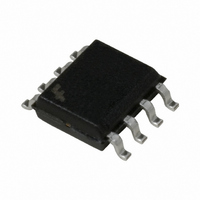FAN7930M Fairchild Semiconductor, FAN7930M Datasheet - Page 13

FAN7930M
Manufacturer Part Number
FAN7930M
Description
IC POWER FACTOR CORR CTRLR 8SOIC
Manufacturer
Fairchild Semiconductor
Datasheet
1.FAN7930M.pdf
(22 pages)
Specifications of FAN7930M
Mode
Critical Conduction (CRM)
Current - Startup
120µA
Voltage - Supply
13 V ~ 20 V
Operating Temperature
-40°C ~ 125°C
Mounting Type
Surface Mount
Package / Case
8-SOIC (3.9mm Width)
Switching Frequency
300 KHz
Maximum Power Dissipation
195 W
Maximum Operating Temperature
+ 125 C
Mounting Style
SMD/SMT
Minimum Operating Temperature
- 40 C
Lead Free Status / RoHS Status
Lead free / RoHS Compliant
Frequency - Switching
-
Lead Free Status / Rohs Status
Lead free / RoHS Compliant
Available stocks
Company
Part Number
Manufacturer
Quantity
Price
Part Number:
FAN7930M
Manufacturer:
FAIRCHILD/仙童
Quantity:
20 000
© 2010 Fairchild Semiconductor Corporation
FAN7930 • Rev. 1.0.1
Because the MOSFET turn on depends on the ZCD
input, switching frequency may increase to higher than
several megahertz due to the miss-triggering or noise
on the nearby ZCD pin. If the switching frequency is
higher than needed for critical conduction mode (CRM),
operation mode shifts to continuous conduction mode
(CCM). In CCM, unlike CRM where the boost inductor
current is reset to zero at the next switch on; inductor
current builds up at every switching cycle and can be
raised to very high current, that exceeds the current
rating of the power switch or diode. This can seriously
damage the power switch and result in burn down. To
avoid this, maximum switching frequency limitation is
embedded. If ZCD signal is applied again within 3.3μs
after the previous rising edge of gate signal, this signal
is ignored internally and FAN7930 waits for another
ZCD signal. This slightly degrades the power factor
performance at light load and high input voltage.
5. Control: The scaled output is compared with the
internal reference voltage and sinking or sourcing
current is generated from the COMP pin by the
transconductance amplifier. The error amplifier output is
compared with the internal sawtooth waveform to give
proper turn-on time based on the controller.
Unlike a conventional voltage-mode PWM controller,
FAN7930 turns on the MOSFET at the falling edge of
ZCD signal. On instance is decided by the external
signal and the turn-on time lasts until the error amplifier
output (V
load is heavy, output voltage decreases, scaled output
decreases, COMP voltage increases to compensate low
Figure 29.
COMP
Figure 30.
) and sawtooth waveform meet. When
Maximum Switching Frequency
Limit Operation
Control Circuit
13
output, turn-on time lengthens to give more inductor
turn-on time, and increased inductor current raises the
output voltage. This is how PFC negative feedback
controller regulates output.
The maximum of V
the maximum turn-on time, and switching stops when
V
The roles of PFC controller are regulating output voltage
and input current shaping to increase power factor. Duty
control based on the output voltage should be fast
enough to compensate output voltage dip or overshoot.
For the power factor, however, the control loop must not
react to the fluctuating AC input voltage. These two
requirements conflict; therefore, when designing a
feedback loop, the feedback loop should be least 10
times slower than AC line frequency. That slow
response is made by C1 at compensator. R1 makes
gain boost around operation region and C2 attenuates
gain at higher frequency. Boost gain by R1 helps raise
the response time and improves phase margin.
For the transconductance error amplifier side, gain
changes based on differential input. When the error is
large, gain is large to make the output dip or peak to
suppress quickly. When the error is small, low gain is
used to improve power factor performance.
COMP
Figure 31.
is lower than 1.0V.
Figure 32.
COMP
. 0
Turn-On Time Determination
Compensators Gain Curve
155
V
is limited to 6.5V, which dictates
/
μ
s
www.fairchildsemi.com












